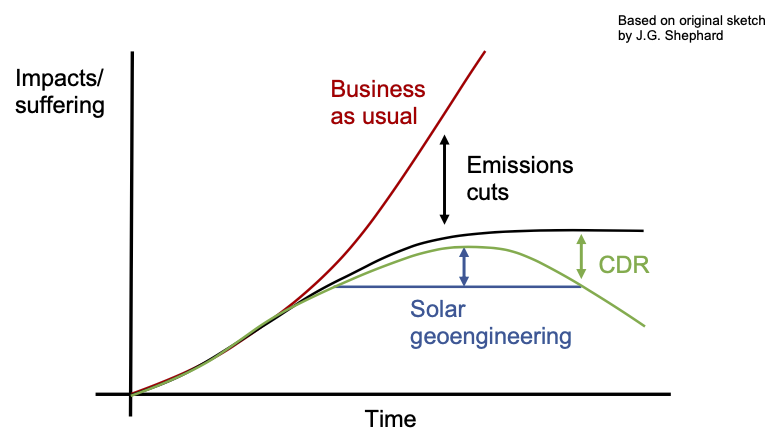2.7 – can we fix climate change with this one weird trick?
Note: development in progress…
geoengineering
Geoengineering is the deliberate intervention of manipulation of the climate (also called “climate engineering”). Geoengineering is often divided into two categories: solar radiation management and carbon dioxide removal.
Solar radiation management is intentional reflection of incoming solar radiation. There are a few different proposed methods that vary in terms of costs, feasibility, effectiveness, and risks:
- Stratospheic aerosol injection
- Marine cloud brightening
- Space mirrors
- Increasing albedo of crops and buildiings
Solar radiation management is cheap and quick, but imperfect (across regions and doesn’t deal with all impacts) and its untested/risky.
Carbon dioxide removal and storage is the extraction of CO2 from the atmosphere to be stored or converted
- Can be stored (usually underground)
- Also efforts to convert to other forms such as energy
Other forms of removing carbon from atmosphere:
- Aforestation/reforestation
- Enhanced weathering
- Bioenergy with carbon capture and storage

issues with geoengineering
There are two primary economic issues with geoengineering: the free-rider problem and moral hazard.
What if we had a technology that was cheap and affected everyone, whether they want it or not? This leads to the free-driver problem, whereby a single economic actor (i.e., country, firm) could unilaterally implement solar geoengineering. The free-driver problem leads to a need to incentivize coordination.
The moral hazard problem arises because geoengineering is a substitute for mitigation. If we have a cheap technology that can reduce the impacts of climate change, then we might be less likely to reduce GHG emissions. This is a problem because geoengineering is not a perfect substitute for mitigation (e.g., geoengineering does not reduce ocean acidification).